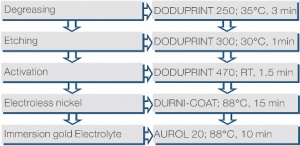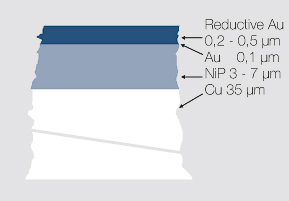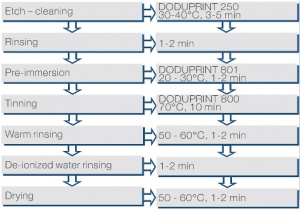Stromlose Beschichtung
Contents
Stromlose Beschichtung
Unter stromloser Metallabscheidung versteht man Beschichtungsverfahren, die ohne Anwendung einer äußeren Stromquelle ablaufen. Sie ermöglichen eine gleichmäßige Metallbeschichtung unabhängig von der geometrischen Form der zu beschichtenden Teile. Aufgrund der sehr guten Streufähigkeit dieser Bäder lassen sich z.B. auch Innenseiten von Bohrungen beschichten.
Prinzipiell können zwei Verfahren der außenstromlosen Metallabscheidung unterschieden werden: Verfahren, bei denen das zu beschichtende Substratmaterial als Reduktionsmittel dient (Austauschverfahren), und solche, bei denen dem Elektrolyt ein Reduktionsmittel zugesetzt wird (Reduktionsverfahren).
Austauschverfahren
Nach dem Austauschverfahren werden hauptsächlich die Metalle Gold, Silber und Zinn abgeschieden. Wenn das zu beschichtende Grundmaterial unedler ist, d.h. ein negativeres Standardpotential besitzt als das in der angrenzenden Lösung vorliegende Metallion, geht es unter Abgabe von Elektronen in Lösung, während das edlere Metallion unter Aufnahme von Elektronen reduziert und an der Elektrode abgeschieden wird. Dieser Vorgang kann so lange ablaufen, bis die gesamte Substratoberfläche mit einer dichten Schicht des edleren Metalls bedeckt ist. Die erreichbare Schichtdicke ist dabei auf ca. 0,1 μm begrenzt Table 1.
| Type of Electrolyte | pH-Range | Coating Properties | Application Ranges | |
|---|---|---|---|---|
| Hardness HV 0.025 | Punity | |||
| Immersion Gold electrolytes | ||||
| AUROL 4 AUROL 16 AUROL 20 |
3.8 - 4.2 5.8 - 6.2 5.8 - 6.2 5.8 - 6.2 |
60 - 80 60 - 80 60 - 80 60 - 80 |
99.99% Au 99.99% Au 99.99% Au 99.99% Au |
Thin gold layers on Ni, Ni alloys, Fe and Fe alloys for PCB technology and technical applications |
Reduktionsverfahren
Eine außenstromlose Metallabscheidung unter Zugabe von Reduktionsmitteln zum Elektrolyt basiert auf der Oxidation des Reduktionsmittels unter Abgabe von Elektronen, die zu einer Reduktion der Metallionen führen. Um eine gezielte Abscheidung aus derartigen Lösungen zu ermöglichen, darf die Metallabscheidung unter Verwendung eines Reduktionsmittels nur unter dem katalytischen Einfluss der Substratoberfläche ablaufen, da sonst eine unkontrollierbare sog. „Wildabscheidung“ stattfindet. Zur Aktivierung verwendet man meist palladiumhaltige Lösungen, welche die Oberflächen mit Palladium bekeimen, das dann im Kupfer- oder Nickelbad katalytisch wirksam wird.
Die Beschichtungsbäder enthalten neben den komplex gebundenen Ionen des abzuscheidenden Metalls Stabilisatoren, Puffersubstanzen, Beschleuniger und ein geeignetes Reduktionsmittel.
Die Bäder arbeiten meist bei höheren Temperaturen (50° bis 90°C). Abgeschieden werden ausschließlich Metalle, die aber badbedingte Fremdeinschlüsse z.B. Abbauprodukte der Reduktionsmittel enthalten. Das Reduktionsverfahren findet praktische Anwendung bei der Herstellung von Kupfer-, Nickel- und Gold-Überzügen.
Reduktive Abscheidung von Nickel/Gold
Electroless deposited nickel coatings with an additional immersion layer of gold are seeing increased importance in the coating of printed circuit boards (PCBs). The process sequence is shown in Figure 1 using the example of the DODUCHEM process.
After the pre-cleaning (degreasing and etching) a palladium sulfate activator is used which activates the exposed copper surfaces on the printed circuit board and thus facilitates the nickel deposition. The electroless working chemical nickel electrolyte contains – besides other ingredients – Sodium-hypophosphite, which is reduced to phosphorus in a parallel occurring process and incorporated into the nickel deposit. At the temperature of 87 – 89°C a very homogeneous nickel-phosphorus alloy layer with approx. 9 wt% P is deposited with layer thicknesses > 5 μm possible. During a consecutive processing step a very thin and uniform layer (< 0.1 μm) of gold is added in an immersion electrolyte. This protects the electroless nickel layer against corrosion achieving a solderable and well bondable surface for thick or fine aluminum bond wires.
It is possible to enhance this layer combination further by adding a immersion palladium layer between the electroless nickel and the gold coating (DODUBOND process). This Pd layer acts as a diffusion barrier and allows the usage of this surface combination also for gold wire bonding.
As an alternative, for gold wire bonding applications a thicker gold layer of 0.2 – 0.5 μm can be applied using an electroless process. Typical electrolytes work at a temperature of approx. 80°C with deposition rates of 0.3 – 0.4 μm per 30 minutes. There are however limitations with these electroless electrolytes concerning their stability and the robustness of the process compared to other electroplating processes which reduces their wider usage Figure 2.
Immersion Deposition of Tin
A tin coating by ion exchange is usually not possible since copper is the more precious metal. By adding thio-urea the electro-chemical potential of copper is reduced to a level (approx. 450 mV, significantly lower than tin) that allows the exchange reaction. Using a suitable electrolyte composition and enhancer solutions like with the DODUSTAN process Figure 3 tin coatings can be produced that, even under usually unfavorable conditions of copper concentrations of 7 g/l in the electrolyte, are well solderable.
The immersion tin deposition is suitable for the production of a well solderable surface on printed circuit boards and electronic components. It is also used as an etch resist against ammonia based solutions or as corrosion and oxidation protection of copper surfaces.



